Modern-day trainees have more information, equipment, and assistance at their disposal than ever before. There’s been a renaissance of knowledge about the myriad training modes, methods, and styles. This has led to a melding of functional methods, including Olympic lifting, pure strength training, functional movements, power, and hypertrophy.
In turn, this pits the individual against an unforeseen challenge. With all of these variables to choose from and the desire to “do everything,” it’s no surprise frustration sets in when it comes to scheduling. You probably tend to gravitate toward your strengths, due to your limited time. You promise yourself to get to those other variables later on down the road.
Another factor to consider is the stress you impose on your central nervous system (CNS). Overtaxing, overtraining, or whatever else you’d like to name it can creep into your best-laid plans and wreak havoc on performance and motivation. Burnout, overall fatigue, and a general lack of motivation set in.
Let’s take a closer look at your wants and needs. We’ll break down how to fit all of these variables into a carefully planned schedule to optimize performance and progression.
Weights, reps, sets, speed. So many factors to consider when writing a program. (Photo courtesy CrossFit Impulse)
The Two Training Categories
For the purposes of this article, I’ll divide several training variables into two general categories:
- Resistance training variables: These are power, strength, hypertrophy, and muscular endurance exercises. This category includes all major forms of weight training and the direct stress they impose on the muscular structure. Whether loads are taken to momentary muscular failure or not, the end result is more specific to muscle groups or individual muscle areas. Muscle groups are fatigued during these movements and require specified rest and recovery.
- Whole-body dynamic training: This includes speed training (sprinting), agility, plyometrics, and speed endurance. These training modalities use a combination of glycolytic and oxidative energy systems without taxing muscle groups directly. These fit more into the realm of conditioning and specificity as they pertain to sports or other forms of performance.
Working Around CNS Fatigue
Both categories can affect your CNS in different ways. Conversely, they may affect each other as well. For example, agility performance can be greatly affected by performing a lower body strength training session just prior. Your CNS will be taxed, as well as your glutes, quadriceps, hamstrings, and lumbar – all vital areas used for performing and stabilizing during agility drills.
Training in an alternating fashion is the most economical and effective method to circumvent the compounding stress on your CNS. Alternating higher and lower intensity levels while also alternating upper- and lower-body training will ensure that your recovery stays on point and your performance is optimized.
Here is an example schedule for resistance and dynamic training variables:
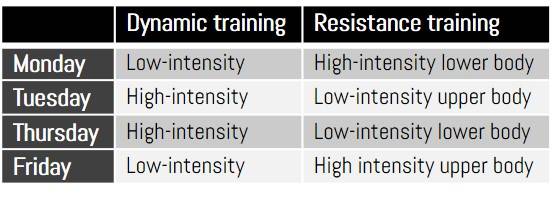
Alternating intensity levels can help make sure you get the most progress out of your respective training variables.
High Versus Low Intensity
It’s traditional in resistance training to quantify intensity as a percentage of a one-rep max (1RM). This can also be determined by performing higher rep maxes, such as 5RM and 10RM. Whatever max is used, increases in that percentage will dictate intensity levels. A set at 40% 1RM is considered low-intensity compared to 95%.
Another way to look at intensity is the level of effort required to reach momentary muscular failure and/or cumulative fatigue. This is usually applied to training for hypertrophy, taxing strength sessions, and high-rep muscular endurance training. Although these variables can also be determined by testing 1RM, they tend to be more fluid and less structured, since fatigue and muscular failure are key components in their effectiveness. For a low-intensity hypertrophy day, you may stop 3-4 reps short of failure on each set or use a load lower than the optimal range (50% to 60%). Lower loads and/or sets terminated prior to failure will stave off overall fatigue, allowing the individual to recover fully and meet the demands of a high-intensity workout the next day.
Determining intensity levels for more dynamic modes of training is a bit trickier. For example, choosing the correct intensity levels in plyometrics will depend on experience, equipment used, and volume. The more experienced you are, the higher your threshold for work. The more challenging the movements (high box jumps), the higher the intensity level. Keep in mind that the main purpose of plyometrics, sprinting, and other forms of dynamic training is to perform at a higher level, not to drain all faculties to pure exhaustion.
Whichever method you choose, pay close attention to CNS stress and recovery. Also monitor your energy and strength levels, dietary habits, and overall motivation and enthusiasm each day. If you see a downward trend, make sure to adjust appropriately.
The Train-It-All Plan
Now let’s take a look at a real-world example of a proper, well-structured schedule which will optimize performance and stave off overtraining and fatigue. You’ll notice that the more dynamic exercises are first in the sequence each day. This is due to the fact that specific plyometric and speed and agility movements require the most technique, skill, and focus, and demand many ancillary muscles for assistance. So it behooves you to avoid fatiguing prior to performing field drills.
Monday
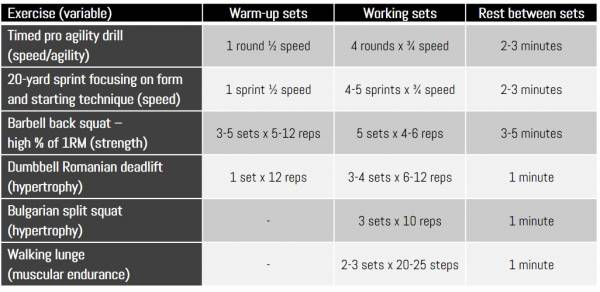
High-intensity lower body and low-intensity dynamic.
Tuesday
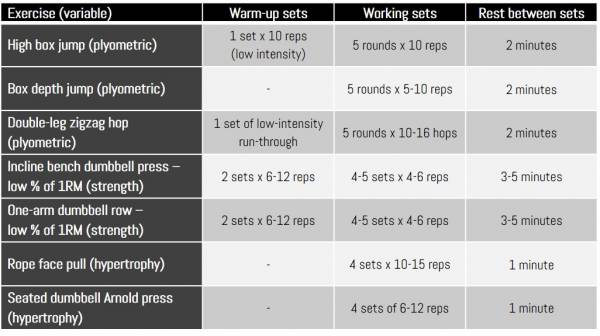
Low-intensity upper body and high-intensity dynamic.
Thursday
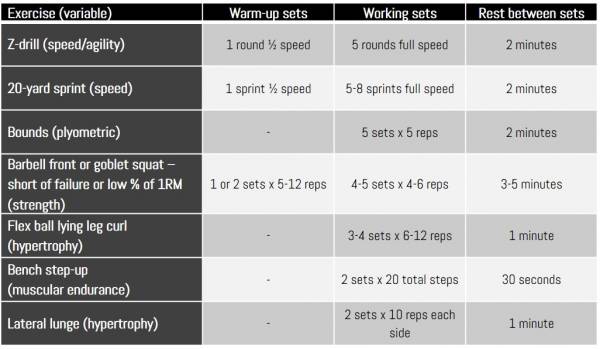
Low-intensity lower body and high-intensity dynamic.
Friday
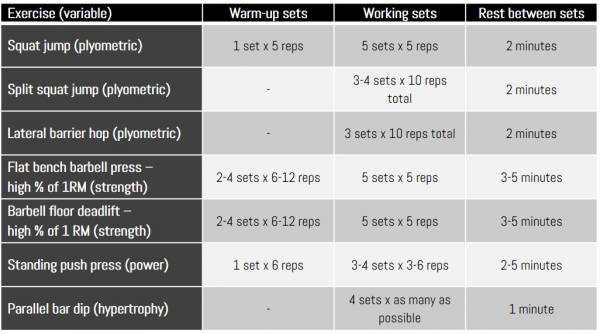
High-intensity upper body and low-intensity dynamic.
Have Your Cake and Eat It Too
Training most or all variables on a weekly basis is complicated, but doable. It just takes some careful planning and close attention to intensity levels each day and week. Once you have a plan in place, you will regulate fatigue much more effectively and see performance and progress levels increase over time – without being sidelined in the process.
Head still swimming? Check this out:
Demystifying Programming for the Everyday Athlete
Coaches: How are you accounting for all these variables?
Do You Have Flexibility In Your Programming?






